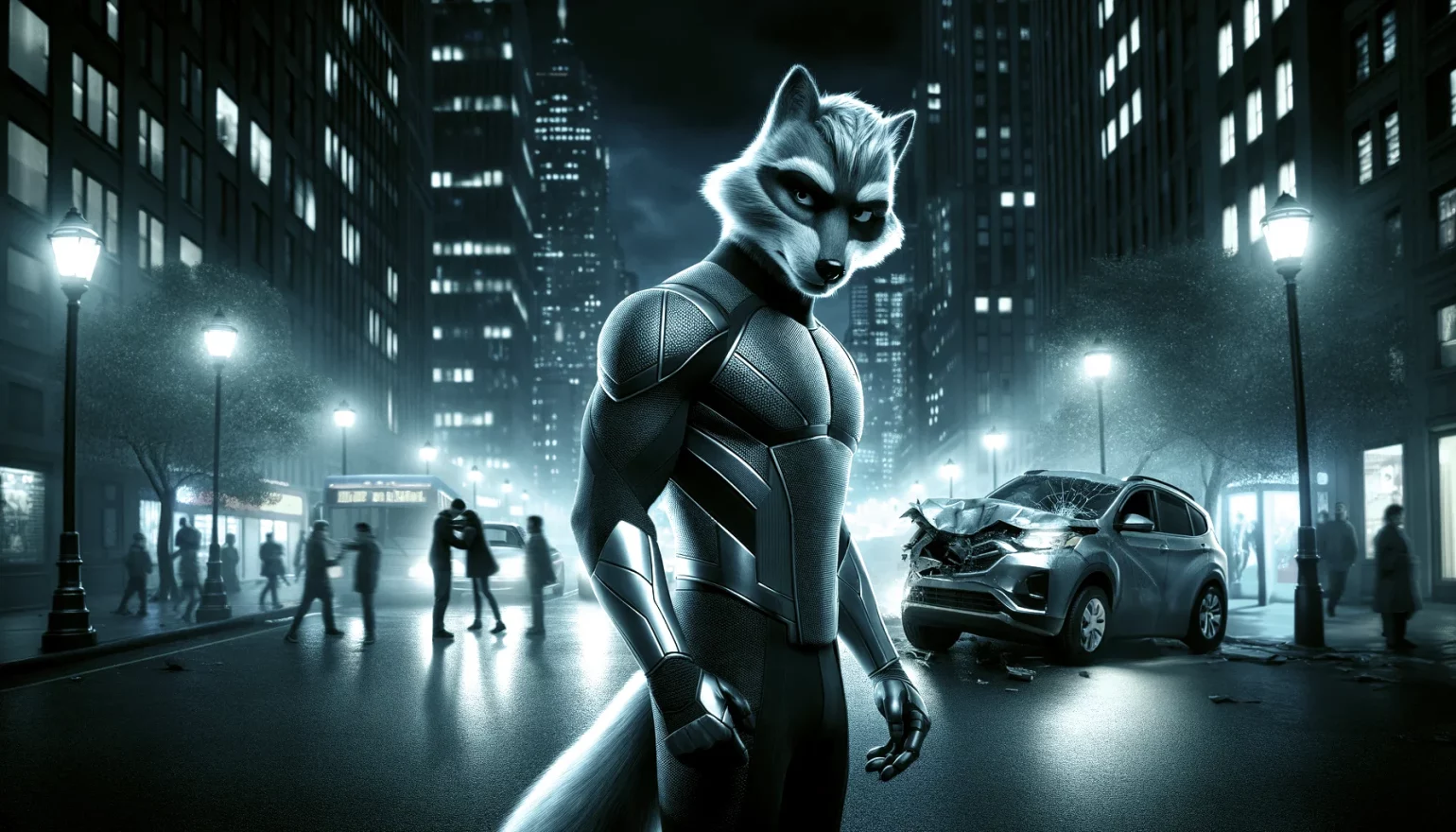In the aftermath of his latest victory, Quicksilver, the silver-furred vigilante, found himself perched on the edge of a rooftop, gazing contemplatively at the city below.
As the city stirred awake, Quicksilver’s mind replayed the events of the previous night. His intervention had successfully prevented a major crime, but the close calls were too many. This time, fortune had been on his side, but the risks he took could easily have cost him his life. The realization weighed heavily on him.
Quicksilver’s thoughts were interrupted by a sudden commotion in the street below. Racing to the scene, he discovered a group of people gathered around a young boy, who was pointing excitedly at a mural on a wall. The artwork depicted Quicksilver in action, a symbol of hope and bravery. But as Quicksilver watched unseen, he overheard the conversations among the crowd.
Parents expressed concern about the dangers of vigilantism, worried about the potential harm that could befall their children in such a volatile environment. They spoke of the ripple effects of Quicksilver’s actions, how his presence, while inspiring, also attracted more danger to their streets. This was a perspective Quicksilver hadn’t fully considered, and it made him question the nature of his mission.
Determined to understand the full impact of his actions, Quicksilver spent the next few days observing the city from the shadows. He noticed how his presence influenced the behavior of both criminals and civilians. The criminals were more cautious, but also more ruthless, knowing that a formidable adversary lurked in the shadows. The civilians, on the other hand, showed a mixture of admiration and fear, their lives inadvertently entangled in his crusade.
This revelation brought Quicksilver to a crossroads. He realized that being a vigilante was a double-edged sword. His actions, while intended to protect, also had the potential to bring harm to those he sought to defend. It was a paradox that he couldn’t ignore.
That night, as Quicksilver once again took to the rooftops, he did so with a new sense of purpose. He understood now that his role as a guardian was not just about confronting criminals, but also about being mindful of the indirect consequences of his actions. He vowed to find a balance, to protect without inadvertently causing harm.
As Quicksilver patrolled the city with his renewed perspective, he remained vigilant, keenly aware of every movement and sound in the bustling urban landscape below. His senses, honed by countless nights on these streets, alerted him to a sudden screech of tires. In an instant, he pinpointed the source: a young boy, frozen in fear, standing in the path of an oncoming car.
Without a moment’s hesitation, Quicksilver sprang into action. Utilizing his agility and speed, he swooped down from the rooftop, a blur of silver against the darkening sky. Reaching the boy just in time, he pulled him out of harm’s way, the rush of the passing car barely missing them. A wave of relief washed over Quicksilver as he set the boy safely on the sidewalk. The child looked up at him with wide, grateful eyes, a silent thank you in his gaze.
However, the relief was short-lived. In avoiding the boy, the car swerved abruptly, colliding with a nearby streetlight. The impact, though not severe, caused a cascade of reactions: the streetlight flickered and went out, plunging a section of the street into darkness, and the car’s occupants emerged, shaken but fortunately unharmed.
Quicksilver’s heart sank as he witnessed the aftermath of his intervention. This was the very scenario he had sought to avoid. While he had saved the boy, his actions had indirectly caused another accident. Thankfully, there were no serious injuries, but the incident was a stark reminder of the delicate balance he strived to maintain.
As the crowd gathered and emergency services began to arrive, Quicksilver retreated to the shadows, his mind racing with thoughts. This experience was a poignant lesson in the unpredictable nature of cause and effect. His intention to do good had inadvertently led to an undesirable outcome, albeit a non-catastrophic one.
In the quiet of the rooftop, Quicksilver reflected on the day’s events. He realized that no matter how careful or well-intentioned, his actions as a vigilante would always have consequences, some unforeseen. This understanding brought with it a sense of humility and a deeper commitment to his role as the city’s silent guardian.
From that day forward, Quicksilver approached his mission with even greater caution and foresight. He understood that being a hero wasn’t just about the bold rescues and confrontations, but also about considering the broader impact of his actions. As he continued to watch over the city, he did so with a heightened sense of responsibility, always mindful of the delicate balance between action and consequence.



